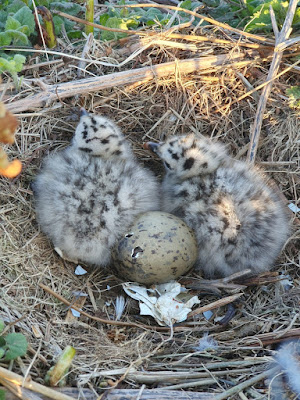Hi! My name's Izzy and I’m the Seabird Monitoring Volunteer
for 2021. I finished my Zoology degree in 2019 and after getting overly excited
about seabirds while doing cetacean research, I’m mixing it up to get excited
about cetaceans while helping with seabird monitoring! I’ve come to Skomer for
the mad month of June to help with the whole island seabird counts and Manx shearwater census.
 |
| Izzy |
Arriving on the island in late May it was my first visit to
Skomer, and it leaves a lasting impression. A flyby of a short-eared owl in the
first 10 minutes and then an evening swim with auks flying above our heads and puffins sat only metres away. I knew it was going to be a special month from
the off.
First up on the to-do list was the small matter of the whole
island seabird counts. The island’s circumference is split into 45 sections, all
of which needed to be surveyed either from land or sea to count the
cliff-nesting birds, specifically guillemots, razorbills, fulmars and kittiwakes. After we’ve done it once, we start over and do the whole island a
second time, hoping the weather is kind enough to get it all done by the end of the 3rd
week of June.
 |
| Leighton rowing the tender |
The 1st of June came along with a whiff. The seal which uses
the boat as a snooze station had really made its mark. After 10 minutes of
scrubbing and a ‘fragrant’ fishy smell we were ready to load the boat up, jump
onboard and head to our first section. Working in teams of 2 we count a
species and then compare our numbers; hoping that they are within 10%. If not,
we’d try again, often talking through sections of birds (not so beneficial with
hundreds of guillemots, but very helpful for the others!). Once we’d ticked off
all 4 species we’d move onto the next section. Counting conditions were often
affected by winds and tides, so on the days we couldn’t count by boat, we’d do
the land count sections instead. These included the mass of birds at Bull Hole,
the Wick and High Cliff, some of which took 5 hours for only a small area!
 |
| Izzy counting Wick |
 |
| Soggy but happy |
 |
| Becca, Samanta and Izzy |
 |
| Becca and Izzy at North Haven |
After some long days of staring through our binoculars, we
got the initial count done within the first week, just in time to start the
Manx shearwater census. This yearly survey monitors the population of Manx
shearwaters by playing calls down burrows and listening for a response.
Most years, we monitor 18 random plots across the island to gather the general
trend, then every 10 years there is a full island census. Each plot has as its centre a metal
pole from which you run 17.84m ropes to create a circular plot of 100m2, checking every burrow in that area. If you visited Skomer in early June and saw us
crawling around on the wet, muddy ground, this was our purpose! We can do the
census in any weather, so it meant the foggy/rainy days we had in the second 2
weeks of June were put to good use getting the plots surveyed.
 |
| The final Manxie plot! |
 |
| Cold-calling Manxies |
Although there were a few moments of worry about getting the
counts done in time, very quickly it all came together and we finished off the
land counts on the 19th of June. A big push on the 20th also saw the final 2
Manxie plots finished, though I do take full blame for the long day; hoping/expecting we
would get them done by lunchtime meant we didn’t get back until past 6.30pm…
Though it is a cliché, this month really has been a
whirlwind. Long days of seabirds, wet bums and laughs. The whole team here on
Skomer really have been great to work in this intense time. Even when the
weather was grim and we were soaked to the skin we were still laughing, singing
ABBA, or telling awful jokes. I’m really hoping this is only a temporary
goodbye to Skomer and that I can be back soon for more of the amazing wildlife
and the lovely community (though I’m not overly upset to be leaving the
overprotective gulls behind!)
 |
| See a bird, click! |
- Izzy, Seabird Monitoring Volunteer




















